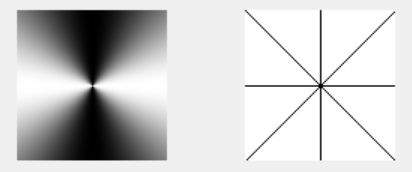Example 1
We start with an example that could easily come from a standard textbook on
calculus.
$$
F(x,y) = \left\{ \begin{array}{ll}
(x^2 - y^2)/(x^2 + y^2) & \quad \mbox{for} \quad (x,y) \ne (0,0) \\
0 & \quad \mbox{for} \quad (x,y) = (0,0)
\end{array} \right.
$$
Let's proceed with some - innocent looking - iterated limits.
$$
\lim_{x\rightarrow\infty} \left( \lim_{y\rightarrow\infty}
\frac{x^2 - y^2}{x^2 + y^2} \right) =
\lim_{x\rightarrow\infty} \left( \lim_{y\rightarrow\infty}
\frac{x^2/y^2 - 1}{x^2/y^2 + 1} \right) =
\lim_{x\rightarrow\infty} (-1) = -1
$$ $$
\lim_{y\rightarrow\infty} \left( \lim_{x\rightarrow\infty}
\frac{x^2 - y^2}{x^2 + y^2} \right) =
\lim_{y\rightarrow\infty} \left( \lim_{x\rightarrow\infty}
\frac{1 + y^2/x^2}{1 + y^2/x^2} \right) =
\lim_{x\rightarrow\infty} (+1) = +1
$$
The iterated limits, apparently, do not commute.
$$
\lim_{x\rightarrow 0} \left( \lim_{y\rightarrow 0}
\frac{x^2 - y^2}{x^2 + y^2} \right) =
\lim_{x\rightarrow 0} \left( \frac{x^2}{x^2} \right) = +1
$$ $$
\lim_{y\rightarrow 0} \left( \lim_{x\rightarrow 0}
\frac{x^2 - y^2}{x^2 + y^2} \right) =
\lim_{y\rightarrow 0} \left( \frac{-y^2}{y^2} \right) = -1
$$
The iterated limits, apparently, do not commute.
Now consider again the iterated limits,
leading to a level of mathematics somewhat below the idealization.
$$
\lim_{x\rightarrow 0} \left( \lim_{y\rightarrow 0}
\frac{x^2 - y^2}{x^2 + y^2} \right) =
\lim_{x\rightarrow 0} \left( \frac{x^2}{x^2} \right)
$$
Then our Axiom comes into effect: Completed infinity is not given.
The limit for $y\rightarrow 0$ therefore may not be considered as completed.
Or the value $y=0$, upon retrospect, is not actually reached: $y\ne 0$.
Therefore what's actually left, instead of the number $0$, is a number slightly
different from $0$, let's call it $\epsilon$:
$$
\lim_{x\rightarrow 0} \left( \lim_{y\rightarrow 0}
\frac{x^2 - y^2}{x^2 + y^2} \right) =
\lim_{x\rightarrow 0} \left( \frac{x^2 - \epsilon^2}{x^2 + \epsilon^2} \right)
= \left( \frac{-\epsilon^2}{+\epsilon^2} \right) = -1
$$
This is the same outcome as with:
$$
\lim_{y\rightarrow 0} \left( \lim_{x\rightarrow 0}
\frac{x^2 - y^2}{x^2 + y^2} \right) =
\lim_{y\rightarrow 0} \left( \frac{-y^2}{y^2} \right) = -1
$$
But wait! The Axiom comes into effect again: Completed infinity is
not given.
The limit for $x\rightarrow 0$ therefore may not be considered as completed.
Or the value $x=0$, upon retrospect, is not actually reached: $x\ne 0$.
Therefore what's actually left, instead of the number $0$, is a number slightly
different from $0$, let's call it $\delta$:
$$
\lim_{y\rightarrow 0} \left( \lim_{x\rightarrow 0}
\frac{x^2 - y^2}{x^2 + y^2} \right) =
\lim_{y\rightarrow 0} \left( \frac{\delta^2 - y^2}{\delta^2 + y^2} \right) =
\left( \frac{\delta^2}{\delta^2} \right) = +1
$$
This is the same outcome as with:
$$
\lim_{x\rightarrow 0} \left( \lim_{y\rightarrow 0}
\frac{x^2 - y^2}{x^2 + y^2} \right) =
\lim_{x\rightarrow 0} \left( \frac{x^2}{x^2} \right) = +1
$$
We conclude that:
$$
\lim_{x\rightarrow 0} \left( \lim_{y\rightarrow 0} F(x,y) \right) =
\lim_{y\rightarrow 0} \left( \lim_{x\rightarrow 0} F(x,y) \right)
$$
So it seems that the iterated limits do indeed commute in the first place.
But the outcome can be $+1$ or $-1$, seemingly at will. The latter would lead to
the conclusion that both iterated limits, actually, do not exist.
It's good to take a closer look at the above.
We will do so by introducing polar coordinates:
$$
x = r\cos(\phi) \quad \mbox{;} \quad y = r\sin(\phi)
$$
Giving:
$$
F(x,y) = \frac{x^2 - y^2}{x^2 + y^2} =
\frac{r^2 ( \cos^2(\phi) - \sin^2(\phi) ) }
{r^2 ( \cos^2(\phi) + \sin^2(\phi) ) } = \cos(2\phi)
$$
Now we can understand immediately why those limits of $F(x,y)$ for $x$ and $y$
indeed do not commute. At $(x,y) = (0,0)$ this function is singular
and it assumes any value between $-1$ and $+1$ there. But the latter is
the case anywhere else in the $(x,y)-$plane. A limit for $x\rightarrow\infty$
and/or $y\rightarrow\infty$ can assume any value between $-1$ and $+1$
as well. The function is sort of a circular wave and has a period $\pi$, with
the radii of a circle as its contour lines.
A few pictures say more than a thousand words.

Black corresponds with function values $(-1)$. White corresponds with function
values $(+1)$. Grey corresponds with function values between these extremes.
Note that the contour lines intersect at the origin, something that can only
happen if the function is singular at that place.
A "natural" way to define limits with the function $F(x,y)$ is to proceed along
contour lines. Just suppose that we decide to approach the origin as well as
infinity along a single contour line. What we have then are single limits.
Select a contour line in the "black" region of $F(x,y)$, namely $x = 0$ . Then:
$$
\lim_{(x,y)\rightarrow(0,0)} \frac{x^2 - y^2}{x^2 + y^2} =
\lim_{y\rightarrow 0} \frac{-y^2}{y^2} = -1
$$ $$
\lim_{(x,y)\rightarrow(\infty,\infty)} \frac{x^2 - y^2}{x^2 + y^2} =
\lim_{y\rightarrow \infty} \frac{-y^2}{y^2} = -1
$$
Select a contour line in the "white" region of $F(x,y)$, namely $y = 0$ . Then:
$$
\lim_{(x,y)\rightarrow(0,0)} \frac{x^2 - y^2}{x^2 + y^2} =
\lim_{x\rightarrow 0} \frac{x^2}{x^2} = +1
$$ $$
\lim_{(x,y)\rightarrow(\infty,\infty)} \frac{x^2 - y^2}{x^2 + y^2} =
\lim_{x\rightarrow \infty} \frac{x^2}{x^2} = +1
$$
Select a contour line in the "grey" region of $F(x,y)$, namely $y=\pm x$ . Then:
$$
\lim_{(x,y)\rightarrow(0,0)} \frac{x^2 - y^2}{x^2 + y^2} =
\lim_{x\rightarrow 0} \frac{x^2 - x^2}{x^2 + x^2} = 0
$$ $$
\lim_{(x,y)\rightarrow(\infty,\infty)} \frac{x^2 - y^2}{x^2 + y^2} =
\lim_{x\rightarrow \infty} \frac{x^2 - x^2}{x^2 + x^2} = 0
$$
Select another contour line in the "grey" region of $F(x,y)$, namely
$y=x/\sqrt{2}$ . Then:
$$
\lim_{(x,y)\rightarrow(0,0)} \frac{x^2 - y^2}{x^2 + y^2} =
\lim_{x\rightarrow 0} \frac{x^2 - x^2/2}{x^2 + x^2/2} = \frac{1}{3}
$$ $$
\lim_{(x,y)\rightarrow(\infty,\infty)} \frac{x^2 - y^2}{x^2 + y^2} =
\lim_{x\rightarrow \infty} \frac{x^2 - x^2/2}{x^2 + x^2/2} = \frac{1}{3}
$$

